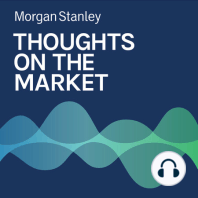3 min listen

Andrew Sheets: A New Outlook on U.S. Bonds
Andrew Sheets: A New Outlook on U.S. Bonds
ratings:
Length:
3 minutes
Released:
Apr 8, 2022
Format:
Podcast episode
Description
Since the Fed’s first rate hike and the inversion of the U.S. Treasury yield curve, the outlook on U.S. government bonds has changed, leading to a new take on U.S. Bonds.-----Transcript-----Welcome to Thoughts on the Market. I'm Andrew Sheets, Chief Cross-Asset Strategist for Morgan Stanley. Along with my colleagues bringing you a variety of perspectives, I'll be talking about trends across the global investment landscape and how we put those ideas together. It's Friday, April 8th at 2:00 p.m. in London. We've made a key change in our strategic cross-asset allocations, closing our underweight to government bonds and are overweight in cash. We did this via U.S. Treasuries. This is a big debate among investors, many of whom are underweight bonds and questioning when to buy them back. There are a couple of reasons why we made this change. First, U.S. 10 year Treasury yields are now above the 2.6% year-end yield target of Morgan Stanley's U.S. interest rate strategists, meaning our forecast for U.S. bond returns are looking better on a cross asset basis. These forecasts should reflect the impact and the uncertainty of higher inflation, quantitative tightening and the growth outlook. Second, another part of our asset allocation framework is asking what economic indicators say about future cross asset performance. On these measures the outlook for U.S. bonds is also improving. For example, bonds tend to do better on a cross asset basis after the yield curve inverts, which recently happened. Another reason we were underweight bonds is that they often underperform other asset classes during the expansion phase of our cycle indicator, a tool we've developed within Morgan Stanley research to measure the ebb and flow of the economic cycle. But this underperformance starts to shift and stop when this indicator gets very extended, and on its current measures, well, it's very extended. Third, while this change was made with a 12 month horizon in mind, we could see some reasons to take action now rather than wait. Recently, cyclical stocks have been sharply underperforming defensive stocks, and that usually coincides with unusually good bond market performance as investors worry about growth. But recently, bonds have been underperforming, even as defensive stocks have worked. That divergence is unusual, but could normalize. We also have an important release of U.S. Consumer Price Inflation next week. While a peak in inflation has so far been elusive, Morgan Stanley's economists believe it may arrive with next week's number. Of course, there are many risks to adding back to bonds at the current juncture. One of those risks is that the U.S. Federal Reserve remains hawkish, and committed to a large number of rate hikes over the next 12 months. While that is certainly possible, the market is now expecting a faster rate hiking path, reducing the chance of a Federal Reserve surprise. To raise our weight of U.S. bonds back to neutral, we are closing or overweight to cash. Cash has performed well year to date, as many other asset classes have seen price declines. But this outperformance is unusual and warrants a more balanced approach for the time being. Thanks for listening. Subscribe to Thoughts on the Market on Apple Podcasts or wherever you listen, and leave us a review. We'd love to hear from you.
Released:
Apr 8, 2022
Format:
Podcast episode
Titles in the series (100)
Mike Wilson: How Confident Are U.S. Businesses in the Economy? by Thoughts on the Market